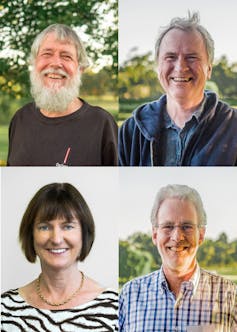Top science prize for 2020 goes to Aussie physicists who helped detect distortions in space-time
- Written by Noor Gillani, Assistant Editor - Technology
This year’s prestigious Prime Minister’s Prize for Science has been awarded to a team of Australian physicists for their contribution to a stellar, reality-bending discovery.
Emeritus professor David Blair and professors Susan Scott, David McClellan and Peter Veitch from the Australian Research Council Centre of Excellence for Gravitational Wave Discovery (OzGrav) were recognised for their role in the first direct detection of gravitational waves in 2015.
The discovery was a result of an astronomical effort by more than 1,000 scientists. It came about a century after Albert Einstein first predicted the existence of gravitational waves, in 1916, a year after he published his theory of general relativity.
Read more: Einstein's folly: how the search for a unified theory stumped him to his dying day
 David Blair (top left), David McClelland (top right), Susan Scott (bottom left) Peter Veitch (bottom right) were awarded the Prize for Science at an online ceremony.
Supplied
David Blair (top left), David McClelland (top right), Susan Scott (bottom left) Peter Veitch (bottom right) were awarded the Prize for Science at an online ceremony.
Supplied
Gravitational waves are distortions in the fabric of space-time that spread outwards from a source at the speed of light. They can be likened to the ripples that emanate when a stone is dropped in water.
In 1997, Blair, McClelland, Scott and Veitch (members of the then new Australian Consortium for Interferometric Gravitational-wave Astronomy) joined the US-based LIGO Scientific Collaboration. This project was focused squarely on the direct detection of gravitational waves and the myriad applications of such a discovery.
Professor Scott said there were immense technological difficulties to overcome:
Everything had to be about a thousand times better, including the shapes of the mirrors, the frequency of the lasers, the acoustic wringing of the mirrors and the vibration isolation. […] This is a story that is 100 years in the making, since Einstein introduced his theory of general relativity in 1915.
The LIGO collaboration’s goal was eventually achieved in 2015, with the detection of a signal caused by two black holes that had collided about 1.3 billion years ago. In 2017 gravitational waves were detected again, this time as a result of two neutron stars crashing into each other.
This observation confirmed neutron stars as the source of previously observed, but unexplained, high-energy gamma ray bursts. Neutron star collisions are the second-most powerful event known to occur in the universe, following black hole mergers.
Read more: Nobel Prize in Physics for two breakthroughs: Evidence for the Big Bang and a way to find exoplanets
Insights gleaned from detection of gravitational waves continue to pave a path for all researchers wanting to wade further into the cosmos with their work. It’s currently aiding efforts to understand what happened in the moments directly after the Big Bang.
In this TED Talk, theoretical physicist Allan Adams explains the implications of what happened in 2015, when a giant laser detector called LIGO directly observed, for the first time, the presence of gravitational waves in the universe.Bringing the spotlight back to Earth, University of Sydney chemistry professor Thomas Maschmeyer was awarded the Prize for Innovation, for his work on two technologies helping advance Australia’s capacity to solve sustainability issues.
Both have vast implications for how we recycle commercial waste and how we can boost the effectiveness of renewable energy storage in harsher environments.
 Mark Dawson is program head of the Peter MacCallum Cancer Centre’s Translational Haematology Program, group leader of the Cancer Epigenetics Laboratory and is also a consultant haematologist.
Supplied
Mark Dawson is program head of the Peter MacCallum Cancer Centre’s Translational Haematology Program, group leader of the Cancer Epigenetics Laboratory and is also a consultant haematologist.
Supplied
On the health side, professor Mark Dawson of the Peter MacCallum Cancer Centre was acknowledged with the Prize for Life Scientist of the Year. Dawson has contributed greatly to the field of epigenetics — which looks at how environmental factors can influence our genes — and its regulation in human health and disease.
His discoveries within human genes have helped revolutionise blood cancer treatments.
Other award recipients included:
- University of New South Wales associate professor Xiaojing Hao. Hao received the Malcolm McIntosh Prize for Physical Scientist of the Year. Her research into solar cells made from “sulphide kesterite” is reshaping the way we think about producing renewable solar energy.
 Xiaojing Hao and her team have set four world records in energy conversion efficiency, most recently in 2017.
Supplied
Xiaojing Hao and her team have set four world records in energy conversion efficiency, most recently in 2017.
Supplied
Flinders University Institute for Nanoscale Science and Technology associate professor Justin Chalker. Chalker received the Prize for New Innovators, for his invention of a class of polymers that could provide sustainable solutions to several challenges facing humankind. His work stands to revolutionise how we access clean air, fresh water and sustainable food production.
Bonython Primary School primary teacher Sarah Fletcher. Fletcher received the Prize for Excellence in Science Teaching in Primary Schools, for her contribution to the STEM program at Bonython Primary School and the wider ACT community.
Willetton Senior High School secondary teacher Darren Hamley. Hamley received the Prize for Excellence in Science Teaching in Secondary Schools, for his ongoing mission to instil a love for science in his students and his overall commitment to science education in Western Australia.
 Teacher Darren Hamley worked with his students to construct Australia’s first fully-licenced, zero-emission solar powered car. It drove across the Nullarbor Plain twice.
Supplied
Teacher Darren Hamley worked with his students to construct Australia’s first fully-licenced, zero-emission solar powered car. It drove across the Nullarbor Plain twice.
Supplied
Authors: Noor Gillani, Assistant Editor - Technology



